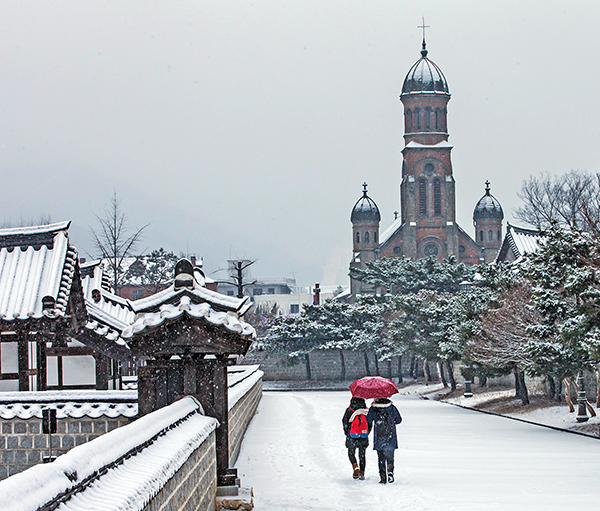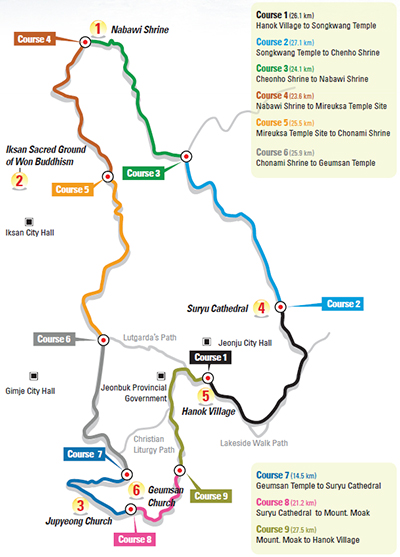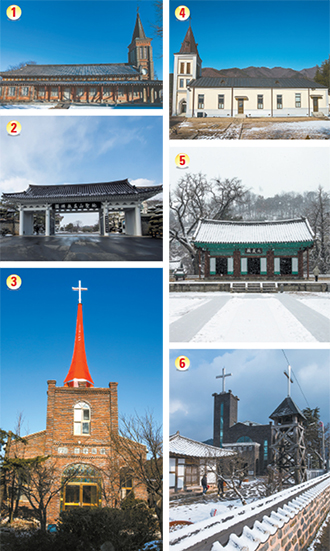Beautiful Sunryegil: One path, many faiths

Course 9 is popular with tourists because it combines religious sites with sightseeing. Entering downtown Jeonju City, Jeondong Cathedral and Gyeonggijeon Shrine, which displays a portrait of King Taejo, the first king of the Joseon Dynasty, come into view. By Shin Dong-yeon
Tens of thousands of people flock to the Camino de Santiago pilgrimage in Spain each year. Also known as the Way of St. James, the Camino is a network of ancient pilgrim routes stretching across Europe to converge at the tomb of St. James in what is now the city of Santiago de Compostela.
The full route, stretching about 780 kilometers (485 miles) from Biarritz, France, is even more crowded around New Year’s, when people of different religions, ages and nationalities strive to get in touch with their inner selves while trekking the path.
But you don’t have to go to Europe for a spiritual pilgrimage. Just head down to North Jeolla, to a path that leads through many faiths.
A cathedral stands next to a Won Buddhism meditation temple. A few steps away from the cathedral is a Protestant church. A hyanggyo, or Confucian school, is visible a few blocks away.
All coexist in North Jeolla along the Beautiful Sunryegil, or Beautiful “Pilgrimage Routes.”
The nine routes stretch a total of 240 kilometers through Jeonju, Iksan, Gimje and Wanju.
The pilgrimage routes include 60 historic religious sites, some of the associated with martyrs of Christianity, Buddhism, Won Buddhism, Roman Catholicism, Confucianism, Cheondoism and ethnic religions.
The pilgrimage project was initiated by the Korea Pilgrimage Culture Institute in 2009 and the routes officially opened last November. The name of the organization has been changed to the World Pilgrimage Festival Organizing Committee, which shares management of the routes with North Jeolla.
Leaders from the local Protestant church, Buddhist temple, Catholic church and Won Buddhist temple all participated in the pilgrimage project as advisers.
“Beautiful Sunryegil is a good example of how religious leaders can communicate with each other,” says Kim Su-gon, 77, a director of the organizing committee.
That’s hardly surprising, since North Jeolla has a long history of harmonious religious diversity.
In Wonpyeong Village, Gimje Catholic priests and Won Buddhism monks helped their neighbors farm during the day and operated a school at night during the period of Japanese colonial rule from 1950-53.
And Buddhist monks sheltered priests who snuck into Songkwang Temple in the latter years of the Joseon Dynasty, when anti-Catholic sentiment was prevalent.
Many might wonder how these religions and their sacred places came to be located so close together in North Jeolla.
Shin Hyeon-suk, a religious affairs officer with the Jeonbuk provincial government, has an answer.
“This area used to be a breadbasket and it was often exploited by outsiders,” says Shin. “Of course, people always needed a holy figure whom they could count on. Once a religion took root, it spread quickly.”
Whether or not you are a believer, Beautiful Sunryegil will surely take you to an inspiring place. Here are highlights of some of the courses.

Course 4: A route with focus
It takes about eight hours to complete Course 4, which has similarities with Camino de Santiago in Spain in that pilgrims can truly focus. Here, they walk past seemingly endless rice paddies.
The only distractions from the tranquility of the path are white-naped cranes and white herons pecking on the grain.
Course 4 starts from the Nabawi sacred site, where a red-brick cathedral with a giwa, or traditional Korean tile, roof is located. The Nabawi Cathedral is the only Catholic church built in the style of a hanok, or a traditional Korean house. It was constructed to commemorate St. Andrew Kim Dae-gun, the first Korean Catholic priest and martyr.
Course 4 ends at the site of Mireuksa Temple. The temple, built in the Baekje Kingdom (18 B.C.?A.D. 660), was once the largest in Asia. All that remains is a small stone pagoda and foundation stone. About 20,000 items from the Baekje period were later found on the site.
Course 7: Six religions, one path
Course 7 stretches about 14.5 kilometers and takes about four hours to complete. It is the shortest course among nine pilgrimage routes, but the most intense, with the most number of religions represented.
The course starts from Geumsan Temple, the largest in North Jeolla. Experts say the location is very compatible with feng shui theory, so ethnic religions such as Jeungsangyo and Daesun Jinrihoe were launched nearby.
The route takes pilgrims to Hampyeong Village and Geumsan Church. The hanok-shaped church was built in 1905.
Next is Wonpyeong Village, where a Won Buddhist temple and Roman Catholic and Protestant churches are all located in the same block.
Course 7 ends at Suryu Cathedral, Hwayul-ri, Gimje. The cathedral is the seat of one of the oldest Catholic communities in Korea, dating back more than 100 years. When the cathedral was ruined during the Korean War, villagers took it upon themselves to raise funds and restore the structure.

1. Nabawi Cathedral located in Iksan, North Jeolla, is built in hanok, or traditional Korean housing, style. 2. Won Buddhism founder Sot’aesan Pak Chungbin founded the Iksan Sacred Ground of Won Buddhism in 1924. 3. Jupyeong Church is located in Gimje. 4. Suryu Cathedral is near Mount Moak. 5. Jeonju Hyanggyo is a Confucian school on the outskirts of Jeonju Hanok Village. 6. Geumsan Church in Hampyeong Village was established in 1905.
With Course 9, you can walk through downtown Jeonju City. Since this course contains sacred religious sites and some sightseeing, it is highly popular with tourists.
The most notable destination is the Supjeongyi sacred site, where thousands of Catholics were persecuted. The course leads to Seomun Church, the first Protestant church in Jeolla province.
Passing the church, the course leads to downtown Jeonju, with Jeondong Cathedral and Gyeonggijeon Shrine, which displays the portrait of King Taejo, first king of the Joseon Dynasty.
Jeondong Cathedral was built in 1791 and is featured in many commercials and films. It still attracts many tourists.
Course 9 ends at Songkwang Temple. A tall horse chestnut tree was cut down five years ago because it stood in front of the main temple. Local legend has it that a Catholic priest snuck into the temple in the 19th century and Buddhist monks gave him a shelter. Later, a missionary gave the horse chestnut tree to the temple to express his gratitude.
If you visit http://www.sunryegil.org, there is more detailed information about each pilgrimage route. A downloadable smartphone application is also available. For accommodations, contact the World Pilgrimage Festival Organizing Committee. Lodging costs 20,000 won ($18.92) per night. (063) 278-1101.
By Hong Ji-yeon [so@joongang.co.kr]










with the Korea JoongAng Daily
To write comments, please log in to one of the accounts.
Standards Board Policy (0/250자)